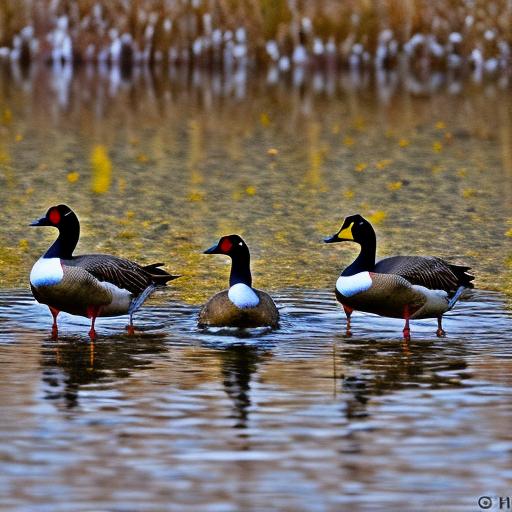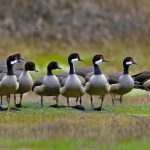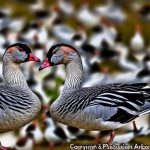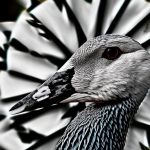Canada Geese, scientifically known as Branta canadensis, are large waterfowl native to North America. They are known for their distinctive black heads, white cheeks, and brown bodies. Canada Geese are highly adaptable and can be found in a variety of habitats, including lakes, rivers, parks, and golf courses.
While Canada Geese are a beautiful sight to behold, they can also cause problems in public areas. One of the main issues is their droppings, which can be unsightly and pose health risks. The droppings can make sidewalks, lawns, and other public spaces slippery and unpleasant to walk on. In addition, Canada Geese can be aggressive during their nesting season, which can pose a threat to people and pets.
Key Takeaways
- Canada Geese can cause damage and health hazards in public areas
- Decoys can be effective in deterring Canada Geese
- There are different types of decoys available for Canada Goose control
- Choosing the right decoys depends on specific needs and situations
- Proper placement and maintenance of decoys is important for their effectiveness
Understanding the effectiveness of decoys in deterring Canada Geese
Decoys are a popular method for deterring Canada Geese from public areas. Decoys work by mimicking the appearance of real geese and creating a sense of danger or competition for resources. When geese see the decoys, they may perceive them as a threat and choose to avoid the area.
One of the benefits of using decoys over other control methods is that they are non-lethal and humane. Unlike methods such as trapping or shooting, decoys do not harm the geese or cause unnecessary suffering. Decoys also have the advantage of being cost-effective and easy to use. They can be placed in strategic locations to deter geese without requiring constant monitoring or maintenance.
Types of decoys available for Canada Goose control
There are several types of decoys available for Canada Goose control. The most common types include silhouette decoys, full-body decoys, and motion decoys.
Silhouette decoys are flat cutouts that resemble the shape of a goose when viewed from a distance. They are lightweight and easy to transport, making them a popular choice for many people. However, they may not be as effective in areas with high goose populations, as the geese may become accustomed to their presence.
Full-body decoys are three-dimensional replicas of Canada Geese. They are more realistic in appearance and can be more effective in deterring geese. However, they are also bulkier and more expensive than silhouette decoys.
Motion decoys are decoys that have moving parts, such as spinning wings or bobbing heads. The movement creates a sense of realism and can be more effective in deterring geese. However, motion decoys require batteries or other power sources to operate and may require more maintenance.
How to choose the right decoys for your specific needs
When choosing decoys for Canada Goose control, there are several factors to consider. First, you should assess the size of the area you need to cover. If you have a large area, you may need more decoys to effectively deter geese. On the other hand, if you have a small area, a few well-placed decoys may be sufficient.
You should also consider the type of environment in which you will be using the decoys. For example, if you will be placing them near water, you may want to choose decoys that are waterproof and can float. If you will be placing them on land, you may want to choose decoys with stakes or stands that can be easily anchored.
Additionally, it is important to consider the behavior of the geese in your area. Some geese may be more wary of certain types of decoys than others. It may be helpful to do some research or consult with experts to determine which type of decoy is most effective for deterring geese in your specific situation.
Proper placement and maintenance of Canada Goose decoys
Proper placement of decoys is crucial for maximum effectiveness. Decoys should be placed in areas where geese are likely to congregate, such as near water sources or feeding areas. They should be spaced out to create a realistic appearance and avoid overcrowding.
It is also important to regularly move the decoys to prevent geese from becoming accustomed to their presence. Geese are intelligent birds and can quickly learn that the decoys pose no threat if they remain in the same location for an extended period of time.
In terms of maintenance, decoys should be cleaned regularly to remove dirt, debris, and droppings. This will help maintain their realistic appearance and ensure they continue to effectively deter geese. If using motion decoys, it is important to regularly check and replace batteries or power sources to ensure they continue to operate properly.
The benefits of using decoys as a humane alternative to other control methods

Using decoys for Canada Goose control offers several humane benefits compared to other control methods. Unlike trapping or shooting, which can cause harm or death to the geese, decoys simply create a visual deterrent. They do not physically harm the geese or cause unnecessary suffering.
Decoys also provide a sustainable solution for Canada Goose management. They can be used year after year without depleting natural resources or causing harm to the environment. In contrast, other control methods may require ongoing trapping or shooting, which can have negative impacts on local ecosystems.
Furthermore, decoys are a non-disruptive method of control. They do not disturb other wildlife or disrupt the natural balance of ecosystems. Decoys simply create a visual deterrent that encourages geese to seek alternative habitats without causing harm to themselves or other species.
Common mistakes to avoid when using decoys for Canada Goose control
While decoys can be an effective tool for Canada Goose control, there are some common mistakes that people make when using them. One common mistake is placing too few decoys in an area. Geese are social animals and are more likely to be deterred by a large group of decoys rather than just a few.
Another mistake is not regularly moving the decoys. As mentioned earlier, geese are intelligent birds and can quickly learn that the decoys pose no threat if they remain in the same location for an extended period of time. Regularly moving the decoys will help maintain their effectiveness.
It is also important to properly maintain the decoys. Dirty or damaged decoys may not effectively deter geese and may even attract them. Regular cleaning and maintenance will help ensure that the decoys continue to look realistic and deter geese effectively.
Combining decoys with other tactics for maximum effectiveness
While decoys can be effective on their own, combining them with other control methods can increase their effectiveness. For example, using noise deterrents, such as sirens or bird distress calls, in conjunction with decoys can create a more realistic and intimidating environment for geese.
Another tactic is using visual deterrents, such as flags or scarecrows, in addition to decoys. These visual deterrents can create a sense of danger or competition for resources, further discouraging geese from entering an area.
It is important to note that combining decoys with other tactics should be done strategically and in a way that does not harm or cause unnecessary stress to the geese or other wildlife. The goal is to create a safe and unattractive environment for geese without causing harm or disruption to the ecosystem.
Legal considerations for using decoys in Canada Goose control
When using decoys for Canada Goose control, it is important to be aware of any legal considerations. In some areas, there may be regulations or restrictions on the use of certain types of decoys or control methods. It is important to familiarize yourself with these regulations and ensure that you are using decoys in a legal and responsible manner.
Additionally, it is important to consider the welfare of the geese when using decoys. While decoys are a non-lethal and humane method of control, it is still important to minimize any unnecessary stress or harm to the geese. Decoys should be used in a way that does not cause unnecessary suffering or disrupt the natural behavior of the geese.
Decoys as a sustainable solution for Canada Goose management
In conclusion, decoys can be an effective and sustainable solution for Canada Goose management in public areas. They provide a non-lethal and humane method of control that deters geese without causing harm or disruption to the ecosystem. Decoys are cost-effective, easy to use, and can be used year after year without depleting natural resources.
When using decoys, it is important to choose the right type of decoy for your specific needs and properly place and maintain them for maximum effectiveness. It is also important to be aware of any legal considerations and use decoys in a responsible and ethical manner.
By using decoys in conjunction with other control methods and considering the welfare of the geese, it is possible to create a safe and unattractive environment for Canada Geese in public areas. This allows for peaceful coexistence between humans and wildlife while minimizing any negative impacts on both parties.
If you’re looking for effective ways to keep Canada geese away, you might be interested in learning about the use of decoys. Decoys can be a great tool for deterring geese from your property, as they create the illusion of a predator presence. However, it’s important to choose the right type of decoy and use them strategically. To learn more about decoys and their effectiveness in goose control, check out this informative article on Poultry Wizard: Decoys: A Powerful Solution for Keeping Canada Geese Away.
Meet Walter, the feathered-friend fanatic of Florida! Nestled in the sunshine state, Walter struts through life with his feathered companions, clucking his way to happiness. With a coop that’s fancier than a five-star hotel, he’s the Don Juan of the chicken world. When he’s not teaching his hens to do the cha-cha, you’ll find him in a heated debate with his prized rooster, Sir Clucks-a-Lot. Walter’s poultry passion is no yolk; he’s the sunny-side-up guy you never knew you needed in your flock of friends!







